Report: Finance, HR and Budgeting for Sustainable Business Success
VerifiedAdded on 2023/01/17
|8
|2041
|61
Report
AI Summary
This report delves into the crucial aspects of financial management and human resource practices essential for achieving sustainable business success. It begins by analyzing the objectives of budgeting, highlighting its role in structuring activities, allocating resources, predicting cash flows, measuring performance, and anticipating financial conditions. The main body of the report then focuses on preparing and analyzing revenue and spending variances, providing a detailed breakdown of budget versus actual figures for various cost types, including revenues, materials, direct labor, and operational expenses. The analysis interprets these variances, identifying favorable and adverse trends, and determines which activities are of major concern to management. Furthermore, the report advises the Twin River Cafe on how to align its practices to support the company's objectives, emphasizing the importance of predicting past budget plans, managing finances effectively, and preparing various types of budgets to control debt and expenses. In conclusion, the report underscores the significance of variance analysis and budgeting as tools to foster operational growth and sustainability.
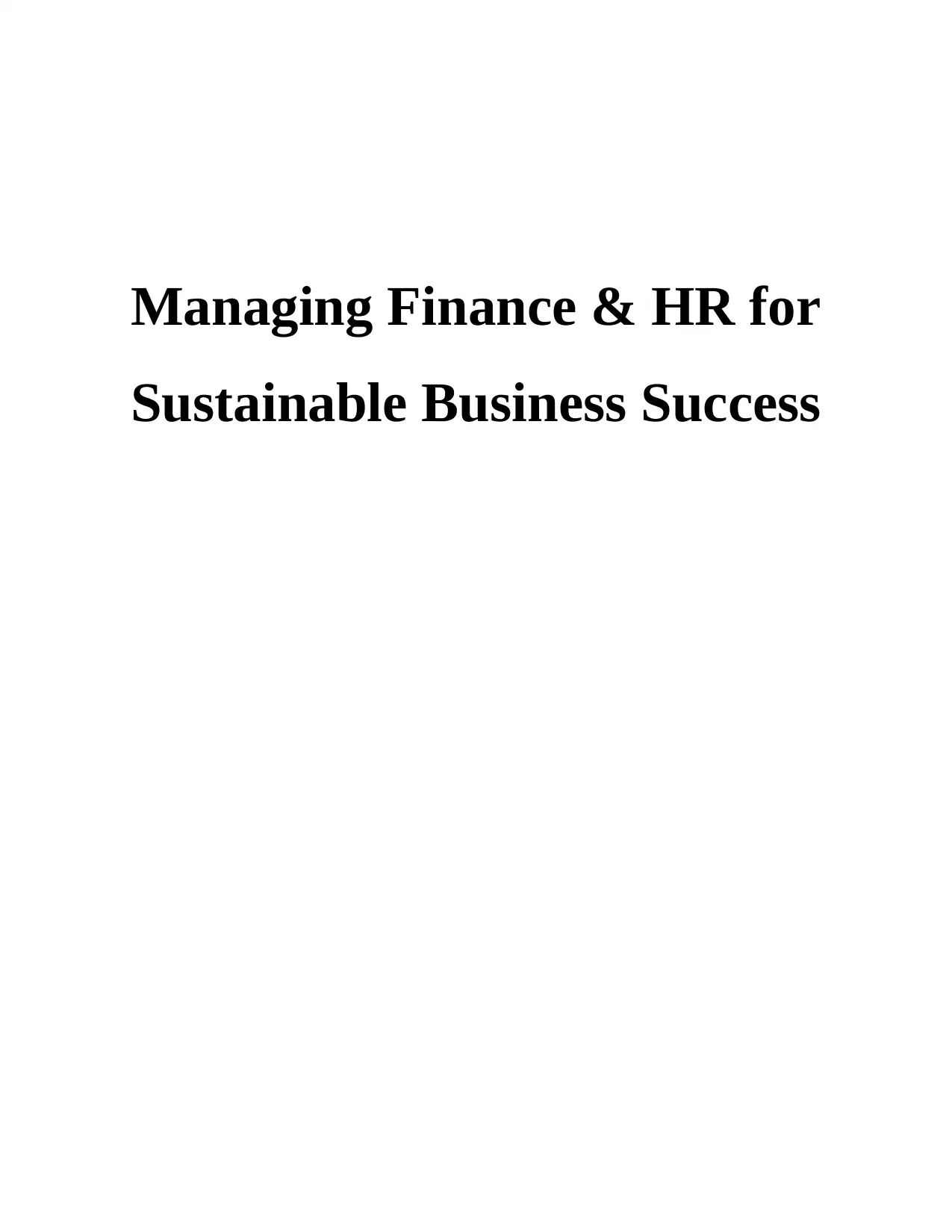
Managing Finance & HR for
Sustainable Business Success
Sustainable Business Success
Paraphrase This Document
Need a fresh take? Get an instant paraphrase of this document with our AI Paraphraser
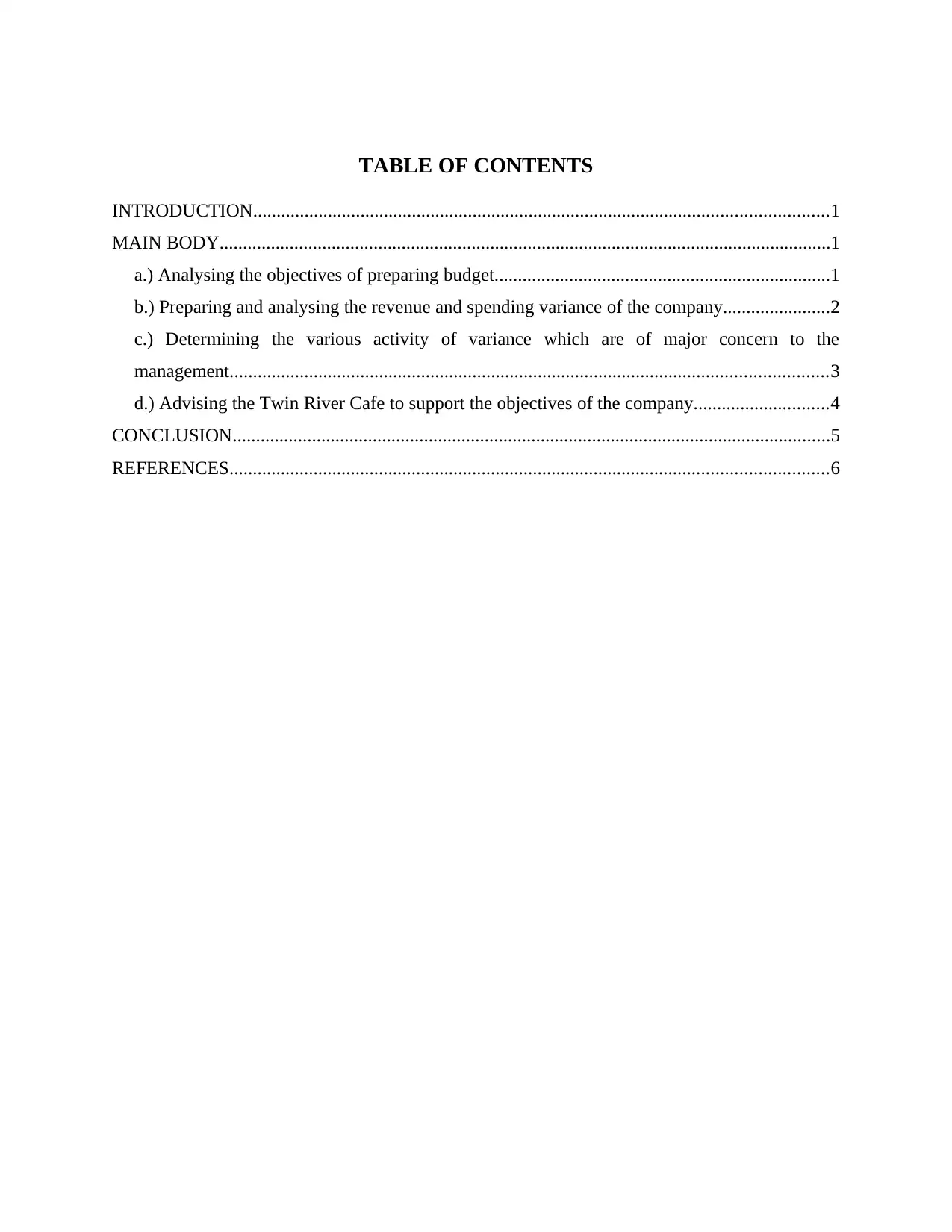
TABLE OF CONTENTS
INTRODUCTION...........................................................................................................................1
MAIN BODY...................................................................................................................................1
a.) Analysing the objectives of preparing budget........................................................................1
b.) Preparing and analysing the revenue and spending variance of the company.......................2
c.) Determining the various activity of variance which are of major concern to the
management................................................................................................................................3
d.) Advising the Twin River Cafe to support the objectives of the company.............................4
CONCLUSION................................................................................................................................5
REFERENCES................................................................................................................................6
INTRODUCTION...........................................................................................................................1
MAIN BODY...................................................................................................................................1
a.) Analysing the objectives of preparing budget........................................................................1
b.) Preparing and analysing the revenue and spending variance of the company.......................2
c.) Determining the various activity of variance which are of major concern to the
management................................................................................................................................3
d.) Advising the Twin River Cafe to support the objectives of the company.............................4
CONCLUSION................................................................................................................................5
REFERENCES................................................................................................................................6
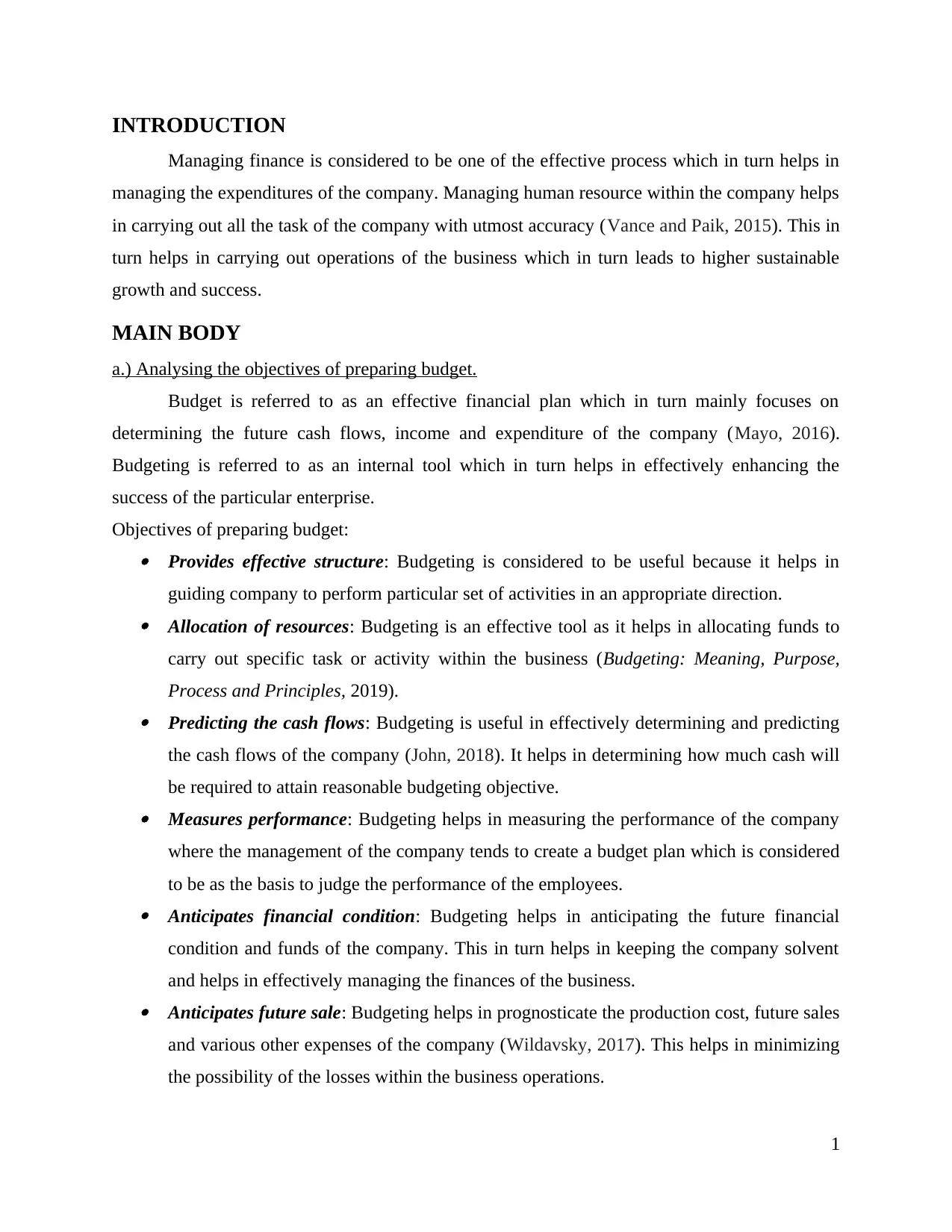
INTRODUCTION
Managing finance is considered to be one of the effective process which in turn helps in
managing the expenditures of the company. Managing human resource within the company helps
in carrying out all the task of the company with utmost accuracy (Vance and Paik, 2015). This in
turn helps in carrying out operations of the business which in turn leads to higher sustainable
growth and success.
MAIN BODY
a.) Analysing the objectives of preparing budget.
Budget is referred to as an effective financial plan which in turn mainly focuses on
determining the future cash flows, income and expenditure of the company (Mayo, 2016).
Budgeting is referred to as an internal tool which in turn helps in effectively enhancing the
success of the particular enterprise.
Objectives of preparing budget: Provides effective structure: Budgeting is considered to be useful because it helps in
guiding company to perform particular set of activities in an appropriate direction. Allocation of resources: Budgeting is an effective tool as it helps in allocating funds to
carry out specific task or activity within the business (Budgeting: Meaning, Purpose,
Process and Principles, 2019). Predicting the cash flows: Budgeting is useful in effectively determining and predicting
the cash flows of the company (John, 2018). It helps in determining how much cash will
be required to attain reasonable budgeting objective. Measures performance: Budgeting helps in measuring the performance of the company
where the management of the company tends to create a budget plan which is considered
to be as the basis to judge the performance of the employees. Anticipates financial condition: Budgeting helps in anticipating the future financial
condition and funds of the company. This in turn helps in keeping the company solvent
and helps in effectively managing the finances of the business. Anticipates future sale: Budgeting helps in prognosticate the production cost, future sales
and various other expenses of the company (Wildavsky, 2017). This helps in minimizing
the possibility of the losses within the business operations.
1
Managing finance is considered to be one of the effective process which in turn helps in
managing the expenditures of the company. Managing human resource within the company helps
in carrying out all the task of the company with utmost accuracy (Vance and Paik, 2015). This in
turn helps in carrying out operations of the business which in turn leads to higher sustainable
growth and success.
MAIN BODY
a.) Analysing the objectives of preparing budget.
Budget is referred to as an effective financial plan which in turn mainly focuses on
determining the future cash flows, income and expenditure of the company (Mayo, 2016).
Budgeting is referred to as an internal tool which in turn helps in effectively enhancing the
success of the particular enterprise.
Objectives of preparing budget: Provides effective structure: Budgeting is considered to be useful because it helps in
guiding company to perform particular set of activities in an appropriate direction. Allocation of resources: Budgeting is an effective tool as it helps in allocating funds to
carry out specific task or activity within the business (Budgeting: Meaning, Purpose,
Process and Principles, 2019). Predicting the cash flows: Budgeting is useful in effectively determining and predicting
the cash flows of the company (John, 2018). It helps in determining how much cash will
be required to attain reasonable budgeting objective. Measures performance: Budgeting helps in measuring the performance of the company
where the management of the company tends to create a budget plan which is considered
to be as the basis to judge the performance of the employees. Anticipates financial condition: Budgeting helps in anticipating the future financial
condition and funds of the company. This in turn helps in keeping the company solvent
and helps in effectively managing the finances of the business. Anticipates future sale: Budgeting helps in prognosticate the production cost, future sales
and various other expenses of the company (Wildavsky, 2017). This helps in minimizing
the possibility of the losses within the business operations.
1
⊘ This is a preview!⊘
Do you want full access?
Subscribe today to unlock all pages.

Trusted by 1+ million students worldwide
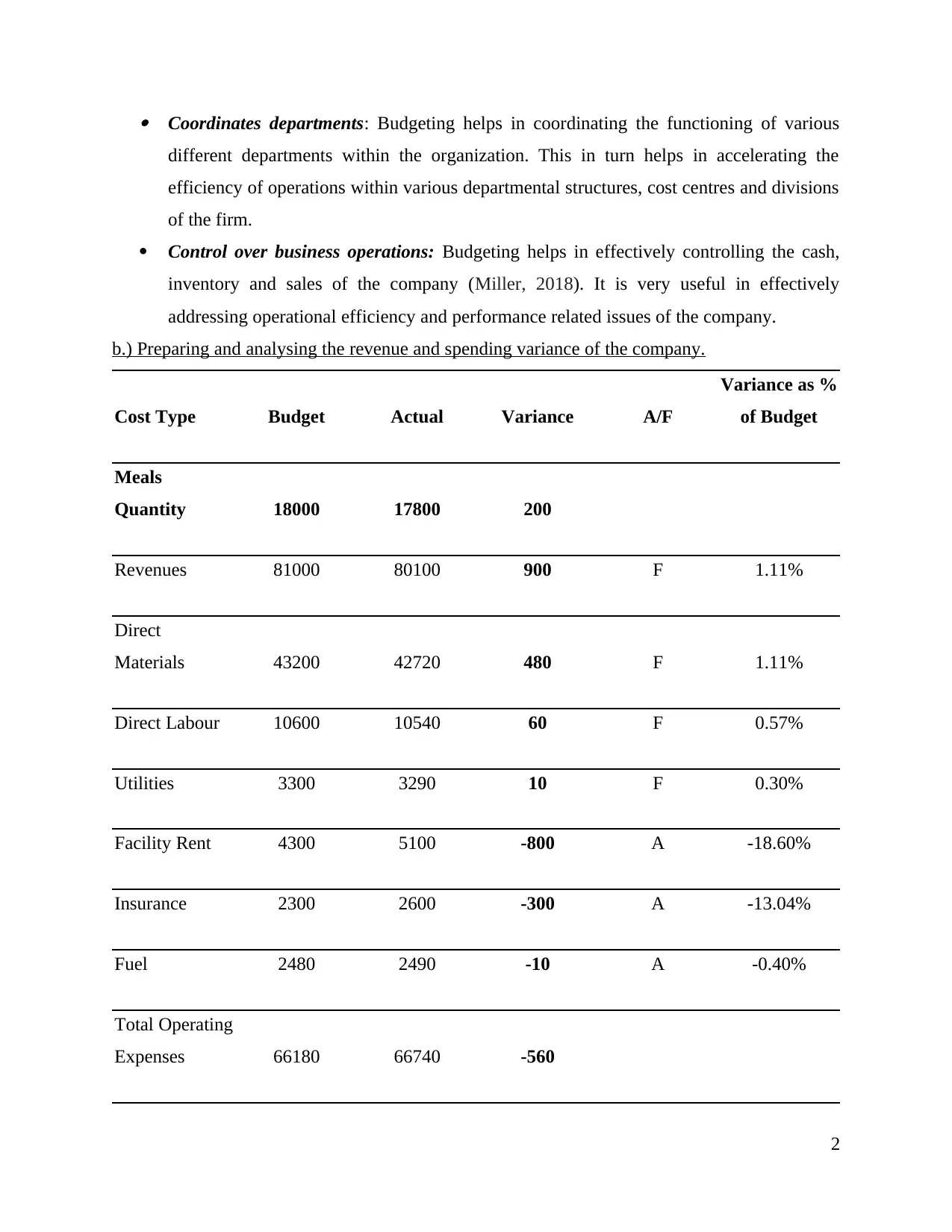
Coordinates departments: Budgeting helps in coordinating the functioning of various
different departments within the organization. This in turn helps in accelerating the
efficiency of operations within various departmental structures, cost centres and divisions
of the firm.
Control over business operations: Budgeting helps in effectively controlling the cash,
inventory and sales of the company (Miller, 2018). It is very useful in effectively
addressing operational efficiency and performance related issues of the company.
b.) Preparing and analysing the revenue and spending variance of the company.
Cost Type Budget Actual Variance A/F
Variance as %
of Budget
Meals
Quantity 18000 17800 200
Revenues 81000 80100 900 F 1.11%
Direct
Materials 43200 42720 480 F 1.11%
Direct Labour 10600 10540 60 F 0.57%
Utilities 3300 3290 10 F 0.30%
Facility Rent 4300 5100 -800 A -18.60%
Insurance 2300 2600 -300 A -13.04%
Fuel 2480 2490 -10 A -0.40%
Total Operating
Expenses 66180 66740 -560
2
different departments within the organization. This in turn helps in accelerating the
efficiency of operations within various departmental structures, cost centres and divisions
of the firm.
Control over business operations: Budgeting helps in effectively controlling the cash,
inventory and sales of the company (Miller, 2018). It is very useful in effectively
addressing operational efficiency and performance related issues of the company.
b.) Preparing and analysing the revenue and spending variance of the company.
Cost Type Budget Actual Variance A/F
Variance as %
of Budget
Meals
Quantity 18000 17800 200
Revenues 81000 80100 900 F 1.11%
Direct
Materials 43200 42720 480 F 1.11%
Direct Labour 10600 10540 60 F 0.57%
Utilities 3300 3290 10 F 0.30%
Facility Rent 4300 5100 -800 A -18.60%
Insurance 2300 2600 -300 A -13.04%
Fuel 2480 2490 -10 A -0.40%
Total Operating
Expenses 66180 66740 -560
2
Paraphrase This Document
Need a fresh take? Get an instant paraphrase of this document with our AI Paraphraser
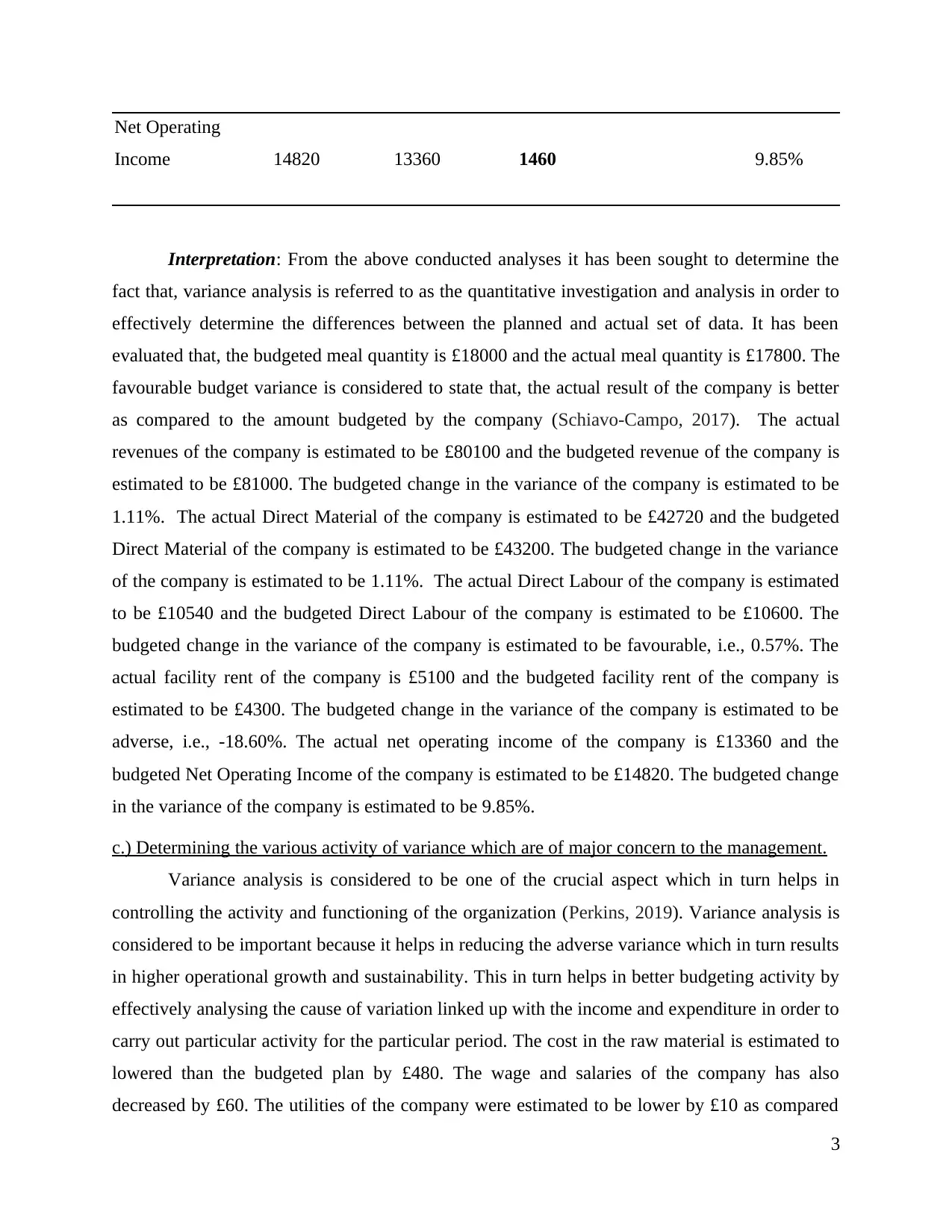
Net Operating
Income 14820 13360 1460 9.85%
Interpretation: From the above conducted analyses it has been sought to determine the
fact that, variance analysis is referred to as the quantitative investigation and analysis in order to
effectively determine the differences between the planned and actual set of data. It has been
evaluated that, the budgeted meal quantity is £18000 and the actual meal quantity is £17800. The
favourable budget variance is considered to state that, the actual result of the company is better
as compared to the amount budgeted by the company (Schiavo-Campo, 2017). The actual
revenues of the company is estimated to be £80100 and the budgeted revenue of the company is
estimated to be £81000. The budgeted change in the variance of the company is estimated to be
1.11%. The actual Direct Material of the company is estimated to be £42720 and the budgeted
Direct Material of the company is estimated to be £43200. The budgeted change in the variance
of the company is estimated to be 1.11%. The actual Direct Labour of the company is estimated
to be £10540 and the budgeted Direct Labour of the company is estimated to be £10600. The
budgeted change in the variance of the company is estimated to be favourable, i.e., 0.57%. The
actual facility rent of the company is £5100 and the budgeted facility rent of the company is
estimated to be £4300. The budgeted change in the variance of the company is estimated to be
adverse, i.e., -18.60%. The actual net operating income of the company is £13360 and the
budgeted Net Operating Income of the company is estimated to be £14820. The budgeted change
in the variance of the company is estimated to be 9.85%.
c.) Determining the various activity of variance which are of major concern to the management.
Variance analysis is considered to be one of the crucial aspect which in turn helps in
controlling the activity and functioning of the organization (Perkins, 2019). Variance analysis is
considered to be important because it helps in reducing the adverse variance which in turn results
in higher operational growth and sustainability. This in turn helps in better budgeting activity by
effectively analysing the cause of variation linked up with the income and expenditure in order to
carry out particular activity for the particular period. The cost in the raw material is estimated to
lowered than the budgeted plan by £480. The wage and salaries of the company has also
decreased by £60. The utilities of the company were estimated to be lower by £10 as compared
3
Income 14820 13360 1460 9.85%
Interpretation: From the above conducted analyses it has been sought to determine the
fact that, variance analysis is referred to as the quantitative investigation and analysis in order to
effectively determine the differences between the planned and actual set of data. It has been
evaluated that, the budgeted meal quantity is £18000 and the actual meal quantity is £17800. The
favourable budget variance is considered to state that, the actual result of the company is better
as compared to the amount budgeted by the company (Schiavo-Campo, 2017). The actual
revenues of the company is estimated to be £80100 and the budgeted revenue of the company is
estimated to be £81000. The budgeted change in the variance of the company is estimated to be
1.11%. The actual Direct Material of the company is estimated to be £42720 and the budgeted
Direct Material of the company is estimated to be £43200. The budgeted change in the variance
of the company is estimated to be 1.11%. The actual Direct Labour of the company is estimated
to be £10540 and the budgeted Direct Labour of the company is estimated to be £10600. The
budgeted change in the variance of the company is estimated to be favourable, i.e., 0.57%. The
actual facility rent of the company is £5100 and the budgeted facility rent of the company is
estimated to be £4300. The budgeted change in the variance of the company is estimated to be
adverse, i.e., -18.60%. The actual net operating income of the company is £13360 and the
budgeted Net Operating Income of the company is estimated to be £14820. The budgeted change
in the variance of the company is estimated to be 9.85%.
c.) Determining the various activity of variance which are of major concern to the management.
Variance analysis is considered to be one of the crucial aspect which in turn helps in
controlling the activity and functioning of the organization (Perkins, 2019). Variance analysis is
considered to be important because it helps in reducing the adverse variance which in turn results
in higher operational growth and sustainability. This in turn helps in better budgeting activity by
effectively analysing the cause of variation linked up with the income and expenditure in order to
carry out particular activity for the particular period. The cost in the raw material is estimated to
lowered than the budgeted plan by £480. The wage and salaries of the company has also
decreased by £60. The utilities of the company were estimated to be lower by £10 as compared
3
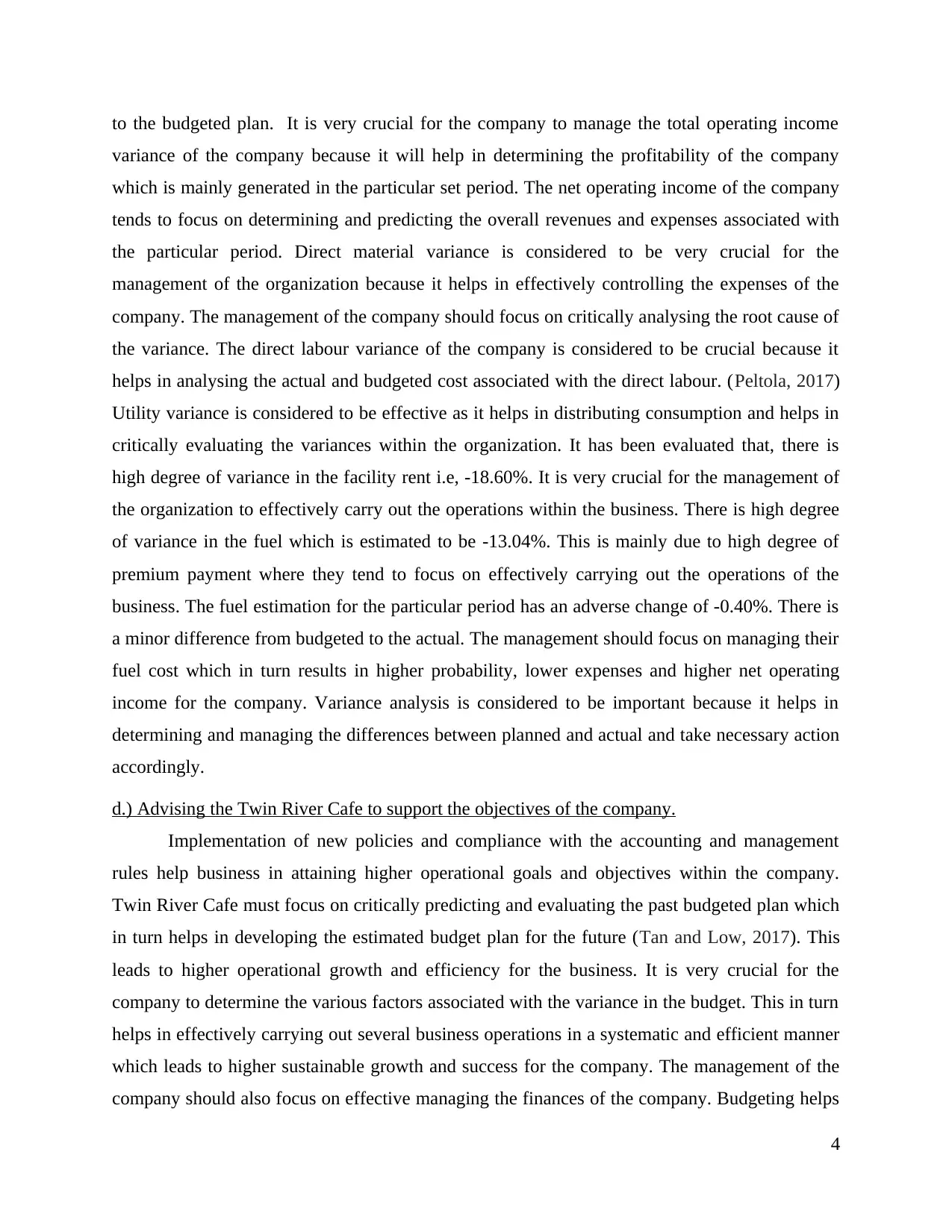
to the budgeted plan. It is very crucial for the company to manage the total operating income
variance of the company because it will help in determining the profitability of the company
which is mainly generated in the particular set period. The net operating income of the company
tends to focus on determining and predicting the overall revenues and expenses associated with
the particular period. Direct material variance is considered to be very crucial for the
management of the organization because it helps in effectively controlling the expenses of the
company. The management of the company should focus on critically analysing the root cause of
the variance. The direct labour variance of the company is considered to be crucial because it
helps in analysing the actual and budgeted cost associated with the direct labour. (Peltola, 2017)
Utility variance is considered to be effective as it helps in distributing consumption and helps in
critically evaluating the variances within the organization. It has been evaluated that, there is
high degree of variance in the facility rent i.e, -18.60%. It is very crucial for the management of
the organization to effectively carry out the operations within the business. There is high degree
of variance in the fuel which is estimated to be -13.04%. This is mainly due to high degree of
premium payment where they tend to focus on effectively carrying out the operations of the
business. The fuel estimation for the particular period has an adverse change of -0.40%. There is
a minor difference from budgeted to the actual. The management should focus on managing their
fuel cost which in turn results in higher probability, lower expenses and higher net operating
income for the company. Variance analysis is considered to be important because it helps in
determining and managing the differences between planned and actual and take necessary action
accordingly.
d.) Advising the Twin River Cafe to support the objectives of the company.
Implementation of new policies and compliance with the accounting and management
rules help business in attaining higher operational goals and objectives within the company.
Twin River Cafe must focus on critically predicting and evaluating the past budgeted plan which
in turn helps in developing the estimated budget plan for the future (Tan and Low, 2017). This
leads to higher operational growth and efficiency for the business. It is very crucial for the
company to determine the various factors associated with the variance in the budget. This in turn
helps in effectively carrying out several business operations in a systematic and efficient manner
which leads to higher sustainable growth and success for the company. The management of the
company should also focus on effective managing the finances of the company. Budgeting helps
4
variance of the company because it will help in determining the profitability of the company
which is mainly generated in the particular set period. The net operating income of the company
tends to focus on determining and predicting the overall revenues and expenses associated with
the particular period. Direct material variance is considered to be very crucial for the
management of the organization because it helps in effectively controlling the expenses of the
company. The management of the company should focus on critically analysing the root cause of
the variance. The direct labour variance of the company is considered to be crucial because it
helps in analysing the actual and budgeted cost associated with the direct labour. (Peltola, 2017)
Utility variance is considered to be effective as it helps in distributing consumption and helps in
critically evaluating the variances within the organization. It has been evaluated that, there is
high degree of variance in the facility rent i.e, -18.60%. It is very crucial for the management of
the organization to effectively carry out the operations within the business. There is high degree
of variance in the fuel which is estimated to be -13.04%. This is mainly due to high degree of
premium payment where they tend to focus on effectively carrying out the operations of the
business. The fuel estimation for the particular period has an adverse change of -0.40%. There is
a minor difference from budgeted to the actual. The management should focus on managing their
fuel cost which in turn results in higher probability, lower expenses and higher net operating
income for the company. Variance analysis is considered to be important because it helps in
determining and managing the differences between planned and actual and take necessary action
accordingly.
d.) Advising the Twin River Cafe to support the objectives of the company.
Implementation of new policies and compliance with the accounting and management
rules help business in attaining higher operational goals and objectives within the company.
Twin River Cafe must focus on critically predicting and evaluating the past budgeted plan which
in turn helps in developing the estimated budget plan for the future (Tan and Low, 2017). This
leads to higher operational growth and efficiency for the business. It is very crucial for the
company to determine the various factors associated with the variance in the budget. This in turn
helps in effectively carrying out several business operations in a systematic and efficient manner
which leads to higher sustainable growth and success for the company. The management of the
company should also focus on effective managing the finances of the company. Budgeting helps
4
⊘ This is a preview!⊘
Do you want full access?
Subscribe today to unlock all pages.

Trusted by 1+ million students worldwide
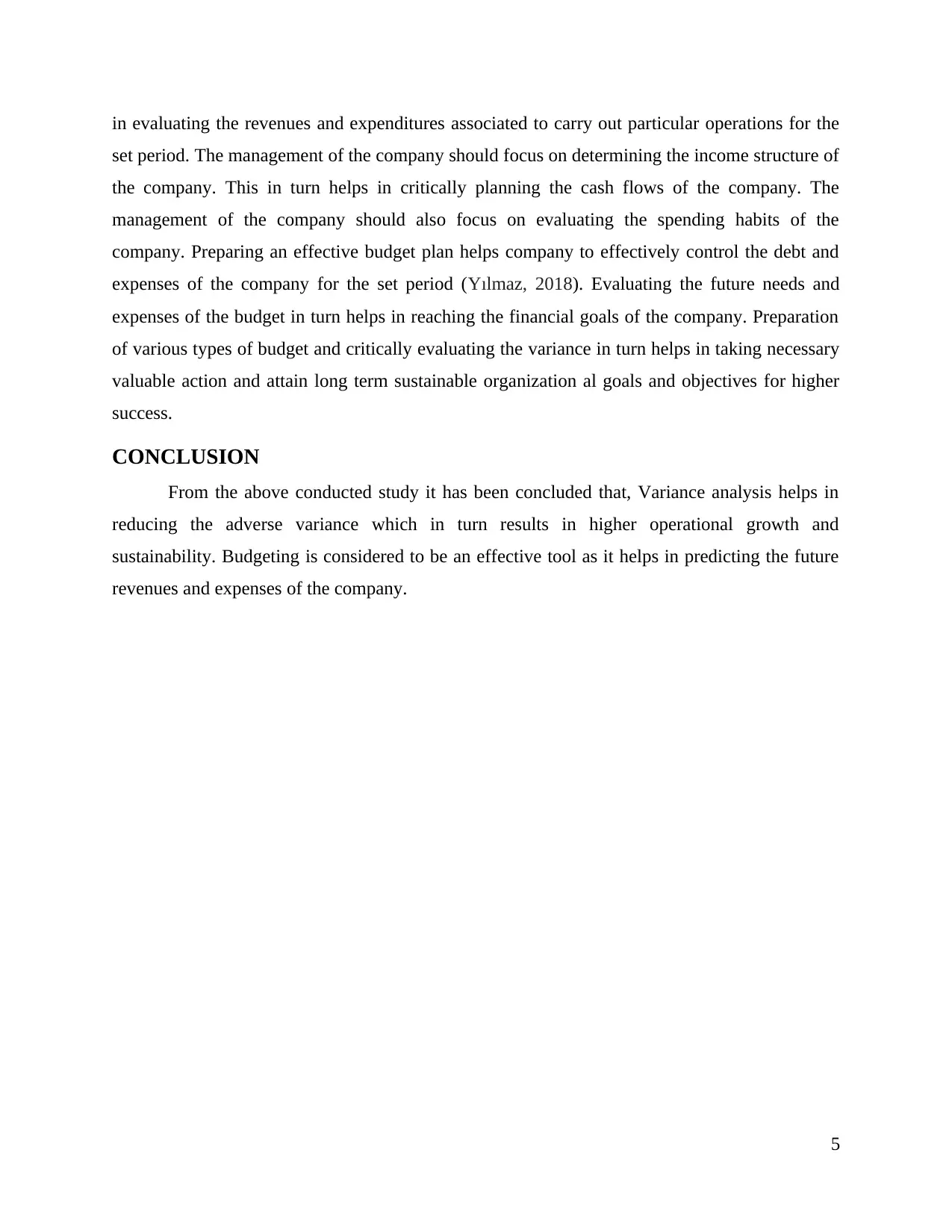
in evaluating the revenues and expenditures associated to carry out particular operations for the
set period. The management of the company should focus on determining the income structure of
the company. This in turn helps in critically planning the cash flows of the company. The
management of the company should also focus on evaluating the spending habits of the
company. Preparing an effective budget plan helps company to effectively control the debt and
expenses of the company for the set period (Yılmaz, 2018). Evaluating the future needs and
expenses of the budget in turn helps in reaching the financial goals of the company. Preparation
of various types of budget and critically evaluating the variance in turn helps in taking necessary
valuable action and attain long term sustainable organization al goals and objectives for higher
success.
CONCLUSION
From the above conducted study it has been concluded that, Variance analysis helps in
reducing the adverse variance which in turn results in higher operational growth and
sustainability. Budgeting is considered to be an effective tool as it helps in predicting the future
revenues and expenses of the company.
5
set period. The management of the company should focus on determining the income structure of
the company. This in turn helps in critically planning the cash flows of the company. The
management of the company should also focus on evaluating the spending habits of the
company. Preparing an effective budget plan helps company to effectively control the debt and
expenses of the company for the set period (Yılmaz, 2018). Evaluating the future needs and
expenses of the budget in turn helps in reaching the financial goals of the company. Preparation
of various types of budget and critically evaluating the variance in turn helps in taking necessary
valuable action and attain long term sustainable organization al goals and objectives for higher
success.
CONCLUSION
From the above conducted study it has been concluded that, Variance analysis helps in
reducing the adverse variance which in turn results in higher operational growth and
sustainability. Budgeting is considered to be an effective tool as it helps in predicting the future
revenues and expenses of the company.
5
Paraphrase This Document
Need a fresh take? Get an instant paraphrase of this document with our AI Paraphraser
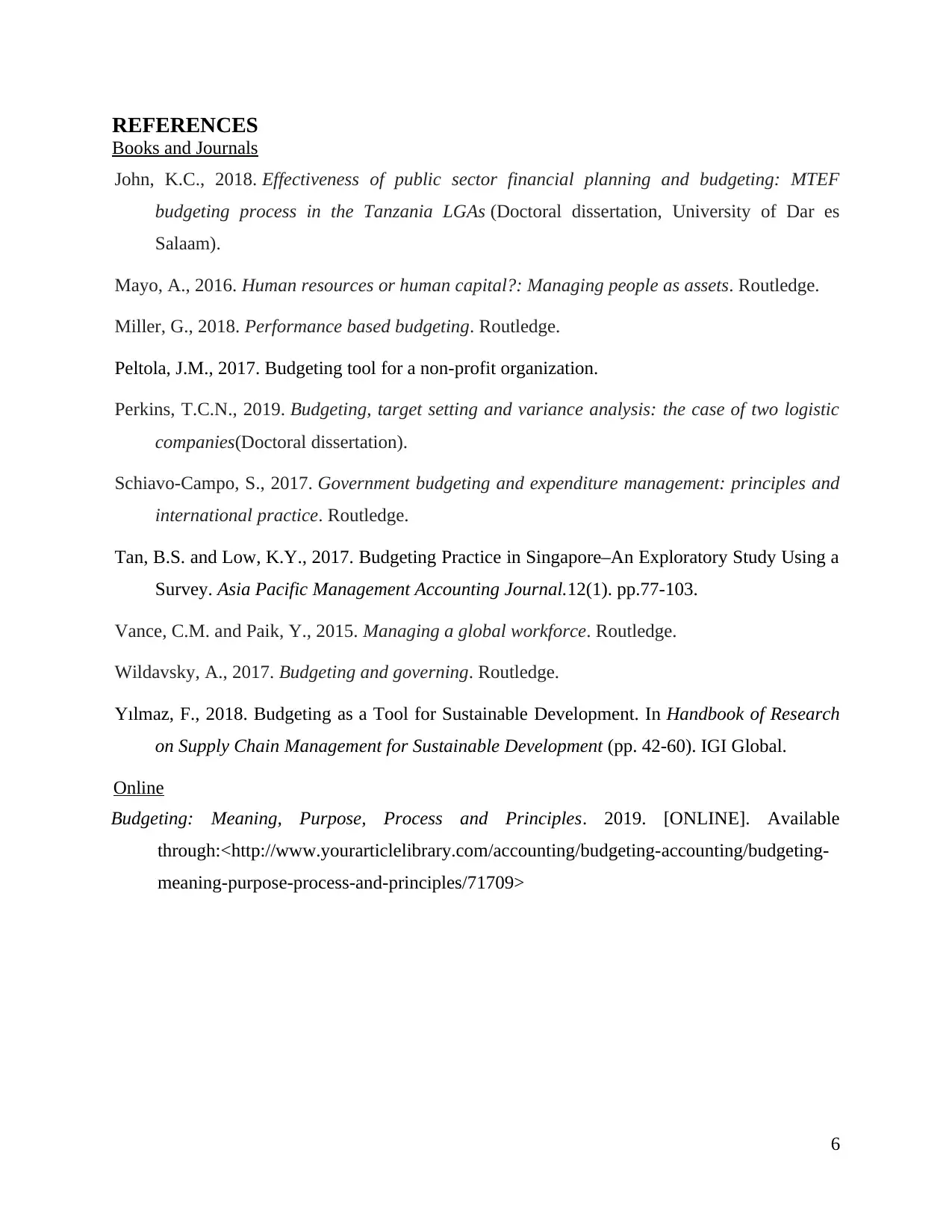
REFERENCES
Books and Journals
John, K.C., 2018. Effectiveness of public sector financial planning and budgeting: MTEF
budgeting process in the Tanzania LGAs (Doctoral dissertation, University of Dar es
Salaam).
Mayo, A., 2016. Human resources or human capital?: Managing people as assets. Routledge.
Miller, G., 2018. Performance based budgeting. Routledge.
Peltola, J.M., 2017. Budgeting tool for a non-profit organization.
Perkins, T.C.N., 2019. Budgeting, target setting and variance analysis: the case of two logistic
companies(Doctoral dissertation).
Schiavo-Campo, S., 2017. Government budgeting and expenditure management: principles and
international practice. Routledge.
Tan, B.S. and Low, K.Y., 2017. Budgeting Practice in Singapore–An Exploratory Study Using a
Survey. Asia Pacific Management Accounting Journal.12(1). pp.77-103.
Vance, C.M. and Paik, Y., 2015. Managing a global workforce. Routledge.
Wildavsky, A., 2017. Budgeting and governing. Routledge.
Yılmaz, F., 2018. Budgeting as a Tool for Sustainable Development. In Handbook of Research
on Supply Chain Management for Sustainable Development (pp. 42-60). IGI Global.
Online
Budgeting: Meaning, Purpose, Process and Principles. 2019. [ONLINE]. Available
through:<http://www.yourarticlelibrary.com/accounting/budgeting-accounting/budgeting-
meaning-purpose-process-and-principles/71709>
6
Books and Journals
John, K.C., 2018. Effectiveness of public sector financial planning and budgeting: MTEF
budgeting process in the Tanzania LGAs (Doctoral dissertation, University of Dar es
Salaam).
Mayo, A., 2016. Human resources or human capital?: Managing people as assets. Routledge.
Miller, G., 2018. Performance based budgeting. Routledge.
Peltola, J.M., 2017. Budgeting tool for a non-profit organization.
Perkins, T.C.N., 2019. Budgeting, target setting and variance analysis: the case of two logistic
companies(Doctoral dissertation).
Schiavo-Campo, S., 2017. Government budgeting and expenditure management: principles and
international practice. Routledge.
Tan, B.S. and Low, K.Y., 2017. Budgeting Practice in Singapore–An Exploratory Study Using a
Survey. Asia Pacific Management Accounting Journal.12(1). pp.77-103.
Vance, C.M. and Paik, Y., 2015. Managing a global workforce. Routledge.
Wildavsky, A., 2017. Budgeting and governing. Routledge.
Yılmaz, F., 2018. Budgeting as a Tool for Sustainable Development. In Handbook of Research
on Supply Chain Management for Sustainable Development (pp. 42-60). IGI Global.
Online
Budgeting: Meaning, Purpose, Process and Principles. 2019. [ONLINE]. Available
through:<http://www.yourarticlelibrary.com/accounting/budgeting-accounting/budgeting-
meaning-purpose-process-and-principles/71709>
6
1 out of 8
Related Documents
Your All-in-One AI-Powered Toolkit for Academic Success.
+13062052269
info@desklib.com
Available 24*7 on WhatsApp / Email
![[object Object]](/_next/static/media/star-bottom.7253800d.svg)
Unlock your academic potential
Copyright © 2020–2025 A2Z Services. All Rights Reserved. Developed and managed by ZUCOL.





